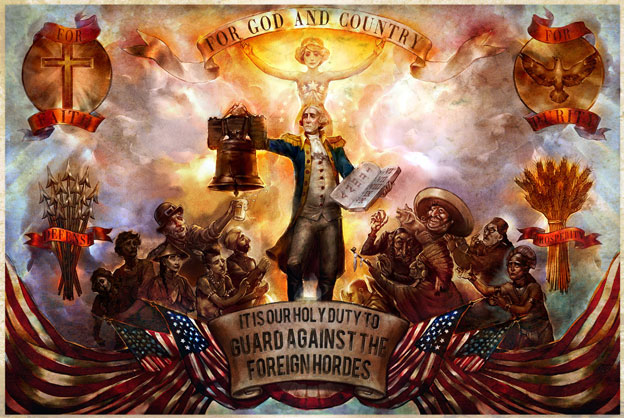
One of the most horrific acts in the building of the US was the workforce acquired. Slaves from Africa and Europe were brought over by the shipload in inhumane conditions. Those that survived the crossing were separated from their families, sold as property and beaten into submission. For centuries these unnamed and unknown servants helped shape America. The world they left behind, the veritable cradle of civilization had been encroached upon by colonists. In their assimilation to "the New World" a good portion of their culture, their history and their traditions were lost. The ancestors that knew the languages, belief systems and wisdom of the homeland died off from work or disease. Slaves learned that the American continent was their new home, only that they would never be allowed to call it such.
Columbia in Bioshock was a microcosm of post-industrial American society. It summed up multiple periods in history, the ugliness of hate speech, propaganda and showed how difficult it was for migrants to integrate into society. The spiritual and religious themes were also very important considering that the tenants of the Christian faith extolled forgiveness and acceptance. These teachings seemed only to apply to the leaders of Columbia and not the servants. The contrast and hypocrisy of this utopian society were the undertones that carried the game. Yet outside of the dialogue started by the developers at Take-Two Interactive the game still revolved around white protagonists. The studio seemed unsure how to write for minority leads, if they were even considered to be stars of the game to begin with. Take-Two seemed as out of the loop as Japanese developers when it came to creating strong black characters. To be fair though the lack of high-profile black characters was the status quo for most AAA titles. Following the trend did not make it right.
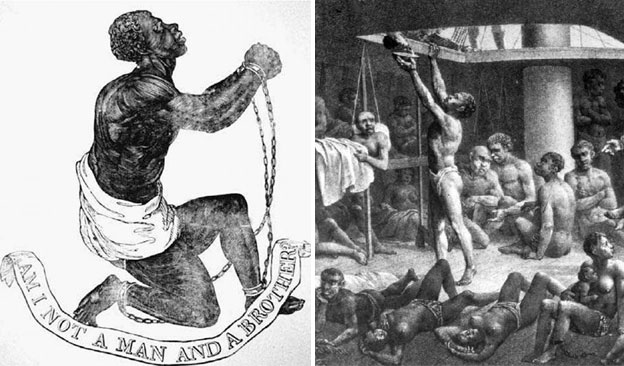
One of the biggest mistakes made by modern game designers were the roots of black fighters and traditional combat systems. The previous blogs showed how black characters in games were given a gimmick. Boxing, basketball or breakdancing were the most common "forms" applied to them. It demonstrated how hopelessly out of touch most developers were with regards to the martial arts of Africa or what arts had been studied by African-Americans outside of boxing and wrestling. African-American martial artists had been making tremendous strides through the 20th century, especially during the Civil-Rights Era. For example Kung-Fu practitioner Ron Van Cief survived a lynching from his own unit after joining the Army. He also survived a tour of duty in Vietnam against very adverse conditions from his fellow soldiers as well as the enemy forces. When he got out he auditioned for a movie role and became a star. He would appear in more than three dozen martial arts films overseas. In the US he and fellow blacks that practiced martial arts were still heavily discriminated against but in Hong Kong they were treated with respect. Van Clief and other black karate, judo and kung fu fighters had mostly been ignored by game developers in Japan and the US for their contributions to the martial arts. Only the stylish characters like Jim Kelley would make a lasting impression to designers.
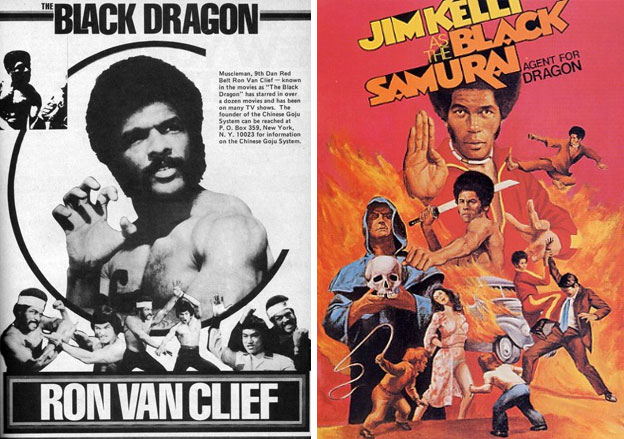
Some of the oldest combat systems the world had ever known were born in Africa. They went back thousands of years, back to the days of the pharaohs. Ancient carvings depicting hand to hand and weapon based combat were on the Beni Hassan Temple in Egypt. The did not record a war or ceremony but appeared to depict a system of grapples and strikes dating back to 3000 B.C. The system was known as Montu Ngumi or Kupigana Ngumi in Swahili. The martial art combined many elements from various tribal cultures into its development including music and dance. These things were not all strikes but included meditation, breathing exercises, religious and spiritual beliefs as well. In these ways Kupigana Ngumi was very similar to the martial arts of Asia. Many systems in China and Japan also relied on mediation and other exercises to help mentally condition their practitioners.
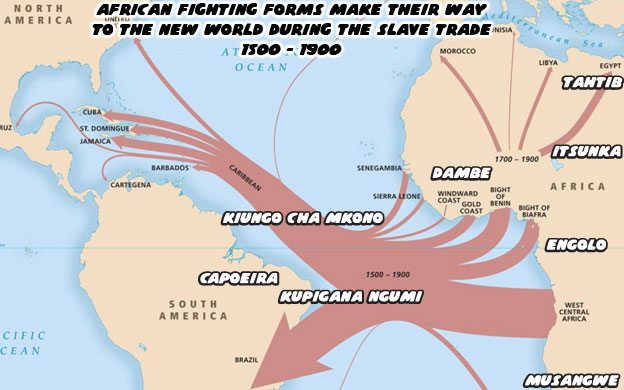
Mental discipline was just as important to most defensive arts as learning how to properly block, throw a punch or kick. People concerned with only learning how to fight often missed the most important lesson the arts had to offer. Self control and character development were paramount to physical training. The difference between learning to fight and learning a system was in the "kata" or forms. In karate practitioners learned a routine that used punches, kicks, blocks and stances. These were called kata. As new moves were learned they were incorporated into the kata. Variations of these kata were long and complex, taking thousands of hours to learn and a lifetime to master. What Kupigana Ngumi did was use music and dance to help practitioners memorize the techniques. Moves flowed from one into the other like steps in a dance. This made for a very fluid system which allowed for individual interpretation. Asian systems were usually fixed forms, having zero room for deviation. Practitioners for Kupigana Ngumi were free to build on their strengths while switching from standing to crouching movements in a nonstop, rhythmical string.
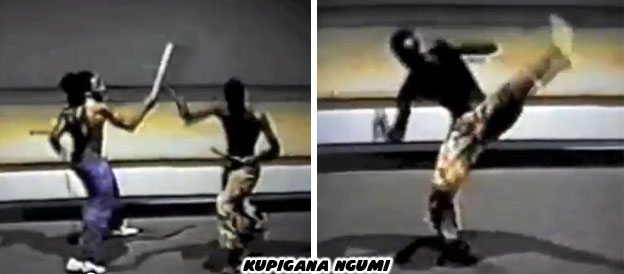
This was a technique that was taught to both men and women starting at a young age. The form was good for core strength development and building arm and leg strength as well. The broad swings of the appendages allowed for even the smallest fighter to learn powerful attacks. Momentum, speed and torsional mechanics replaced the need for big muscles while striking. The constant shift from foot to foot and crouching moves meant that some practitioners were were extremely good at evasion. Pacifists or those that could not generate the right "snap" for a kick could still make it out of a tight spot thanks to the system. The low stances were also useful for those that had fallen or were tackled. The majority of real world fights ended up on the ground and people that knew how to strike and evade from a low position had the advantage.
The form followed slave practitioners to the West Indies, the Caribbean and eventually the Americas. Consider the blasphemous stereotype that slaves were born with natural rhythm and the ability to dance. Could it be possible that what those early slave owners had witnessed were some of the first Kupigana Ngumi moves in the New World? Any accurate report of what customs and traditions the Africans had brought over were lost in time and simply never recorded. The settlers considered them savage and sub-human after all. The slave owners would have destroyed any artifacts the Africans brought and would have worked tirelessly to suppress any spiritual beliefs they had. The history books would have made no mention of what African culture was like before the slave trade started. The brutality of the slave owners had twisted the generations born on the new continent. During the centuries of slavery and apartheid the African fighting arts had evolved into a new form. The large sweeping motions of Kupigana Ngumi had all but disappeared. In its place was a system that was far more brutal and to the point. Kiungo Cha Mkono or "Shackle Hands" was a form of trapping and striking that was very similar to the Chinese Wing Chun school of boxing. It could be practiced by any person regardless of gender or age. It was born from the necessity of slaves and prisoners to defend themselves while handcuffed and chained together. The strikes used in the system were meant for maximum soft tissue damage. Exposed ears, eyes and throats were prime targets. Jabbing with fingers and scratching out eyes were fair attacks considering what sort of life the Africans were being sold into.
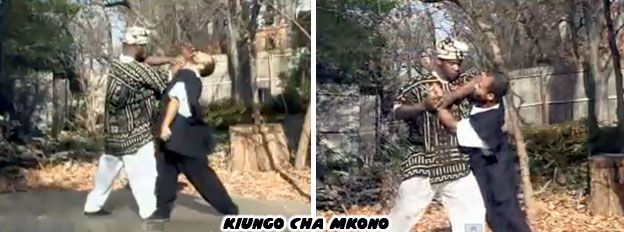
Kupigana Ngumi and Kiungo Cha Mkono survived a long and ugly history and were still being taught thousands of years later. More than any boxer, basketball player or breakdancer it would have been amazing to have seen a fighting game character use the systems. Those that played arcade games in the '90s had actually been exposed to parts of the African fighting culture. It turned out that the genre was not solely not about stereotypical gimmicks being placed on minority characters. Some of the greatest game characters introduced almost 20 years ago were rooted in reality. The next blog will look at the proud characters that highlighted the beautiful fighting art. As always if you enjoyed this blog and would like to sponsor me please visit my Patreon page and consider donating each month, even as little as $1 would help make better blogs and even podcasts!

No comments:
Post a Comment